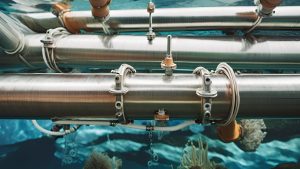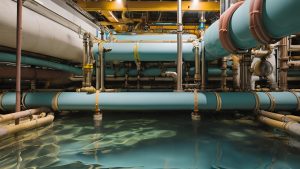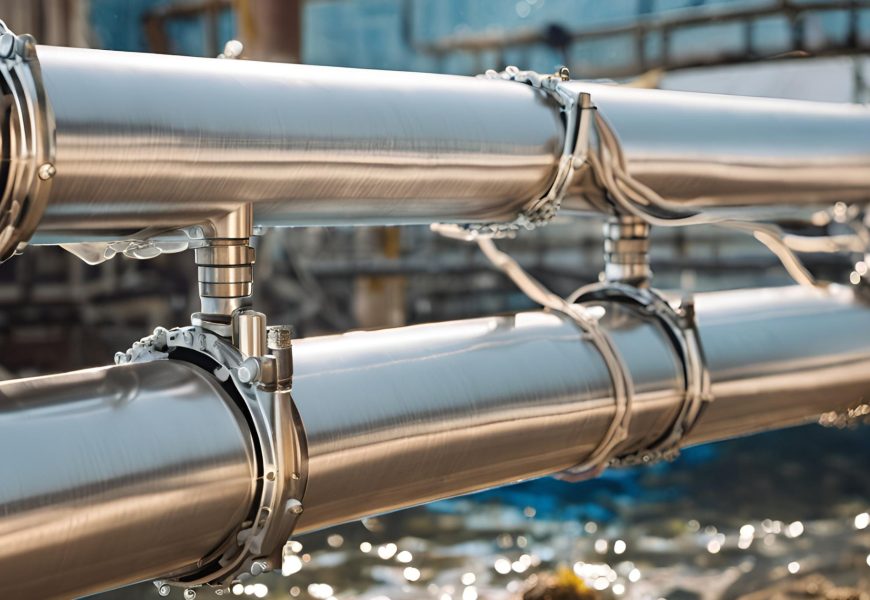Underwater piping systems are vital to modern industries, facilitating the transportation of essential resources such as oil, gas, and water across oceans and seas. These intricate networks of pipelines endure extreme conditions, from high pressure to corrosive environments, making them engineering marvels that require precise planning, durable materials, and expert craftsmanship. While stainless steel components, such as SS 304 pipes, play a role in ensuring the integrity of underwater systems, the complexity of designing and installing these pipelines extends far beyond material selection.

The Role of Underwater Piping in Modern Industry
Underwater pipelines serve as lifelines for many industries, particularly in the energy sector. Oil and gas extraction from offshore rigs, for example, relies heavily on submarine piping to transport crude oil and natural gas from seabeds to onshore refineries. Without these pipelines, the energy supply chain would be drastically affected, as transporting such large volumes of fuel by ship would be inefficient and costly.
In addition to the oil and gas industry, underwater piping is used for water supply systems, sewage disposal, and even underwater cables for telecommunications. As industries expand and explore new resources in remote underwater locations, the need for robust and reliable pipelines continues to grow.

For their underwater piping projects, companies rely on a trusted stainless steel 304 pipe supplier to ensure a steady supply of high-quality pipes in bulk, essential for meeting demanding installation timelines and maintaining system integrity.
Challenges of Underwater Piping
Installing and maintaining pipelines on land is challenging enough, but working underwater presents additional hurdles that require careful consideration. Some of the main challenges include:
- Extreme Pressure and Depth: Underwater pipelines, especially those installed deep beneath the ocean’s surface, face immense pressure. The deeper the pipeline, the greater the force exerted by the surrounding water, which can strain the pipeline and its connections. To withstand this pressure, pipelines must be constructed using materials. That is strong yet flexible enough to handle the forces at play.
- Corrosion and Marine Conditions: Seawater is highly corrosive, and underwater pipelines are constantly exposed to moisture and salinity. Over time, this exposure can weaken the metal, leading to leaks and other issues. SS 304 pipes, with their corrosion-resistant properties, are often used in underwater piping systems. For their ability to withstand such harsh conditions.
- Subsea Terrain and Movement: Underwater pipelines must navigate a variety of terrains, from flat seabeds to rocky or uneven surfaces. In some cases, pipelines may even cross fault lines, requiring them to be flexible enough to absorb movement without breaking. Engineers must account for these variables during the design phase to ensure long-term stability.
- Environmental Impact: Constructing underwater pipelines can have environmental consequences, such as disrupting marine ecosystems or polluting the water. Therefore, pipeline projects often require environmental impact assessments to minimize harm to aquatic life. Materials like stainless steel, which are less likely to leach harmful chemicals into the water, are often chosen for these applications.
The Engineering Behind Underwater Piping Systems

The construction of underwater piping systems involves several phases, each of which requires careful planning and execution. From the initial design to the final installation, engineers must account for a range of factors to ensure the pipeline’s functionality and longevity.
-
Design and Material Selection
Designing an underwater pipeline begins with understanding the purpose and environment in which it will operate. Engineers must determine the pipeline’s diameter, wall thickness, and material based on the type of fluid. It will carry and the depth at which it will be installed. Stainless steel grades like SS 304 and SS 316 are frequently chosen for their strength, corrosion resistance, and durability in marine environments.
While SS 304 pipes are ideal for freshwater or low-salinity applications, SS 316 is often preferred for pipelines exposed to higher levels of saltwater. This grade contains molybdenum, which enhances its corrosion resistance in harsh marine environments.
-
Pipe Laying Techniques
- S-lay method: In this method, pipes are welded together on a ship and gradually lowered to the seabed in an S-shape, where they are laid along the planned route. This method is ideal for shallower depths and calm seas.
- J-lay method: This method involves dropping pipes vertically into the water in a J-shape, making it suitable for deeper installations. The J-lay technique is often used for offshore oil and gas pipelines, which require installation at great depths.
Both methods require precise coordination between onshore and offshore teams, as even a small error during installation can lead to costly repairs or environmental hazards.
-
Welding and Testing
Welding underwater pipelines requires advanced technology to ensure that the joints are strong enough to withstand pressure and environmental conditions. Once the pipes are welded, they undergo rigorous testing, including pressure tests. To ensure that no leaks or weak points exist. Non-destructive testing (NDT) methods, such as ultrasonic and X-ray inspections. Are used to check the integrity of the welds without damaging the pipes.
Materials like SS 304 pipes are particularly well-suited for welding, as stainless steel is known for its excellent weldability. After welding, the pipes are inspected for any defects that could compromise the system’s performance.
-
Corrosion Protection
While stainless steel is highly resistant to corrosion, underwater pipelines often receive additional protective coatings to further enhance their lifespan. These coatings, typically made from epoxy or polyethylene, act as a barrier between the pipeline and the surrounding seawater, reducing the risk of corrosion over time.
The Role of Stainless Steel in Underwater Piping
Stainless steel, particularly SS 304 pipes, plays a crucial role in underwater piping due to its corrosion-resistant properties and ability to withstand the harsh marine environment. Its non-reactive nature makes it an ideal material. For transporting fluids such as oil, gas, and water without compromising safety or efficiency.
SS 304 pipes are also known for their durability and strength, making them suitable for both shallow and deep-water applications. In some cases, higher-grade stainless steels, like SS 316. Are uses to provide additional protection against extreme salinity and temperature variations.
The Future of Underwater Piping
As industries continue to explore new offshore resources, the demand for advanced underwater piping systems will only increase. Innovations in material science, such as the development of even more corrosion-resistant alloys and advanced coatings. Are expects to extend the lifespan of underwater pipelines and reduce maintenance costs.
Stainless steel will remain a key material in this evolution, thanks to its combination of strength, durability, and resistance. To the challenging conditions found in marine environments.
Conclusion
Underwater piping is a vital component of many modern industries, ensuring the smooth transportation of resources beneath the ocean’s surface. While challenges such as pressure, corrosion, and terrain pose significant hurdles, advances in engineering and materials. Like SS 304 pipes have made it possible to create long-lasting, efficient underwater pipeline systems. As technology continues to evolve, the future of underwater piping holds great promise for improved efficiency, sustainability, and durability.
Read more about – Bussiness Blogs
















